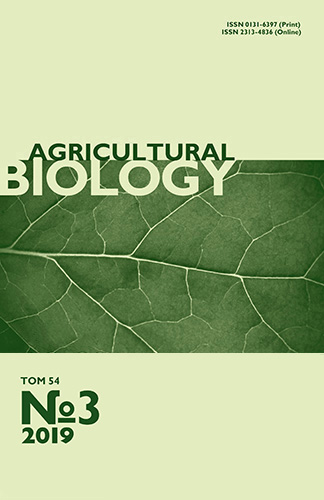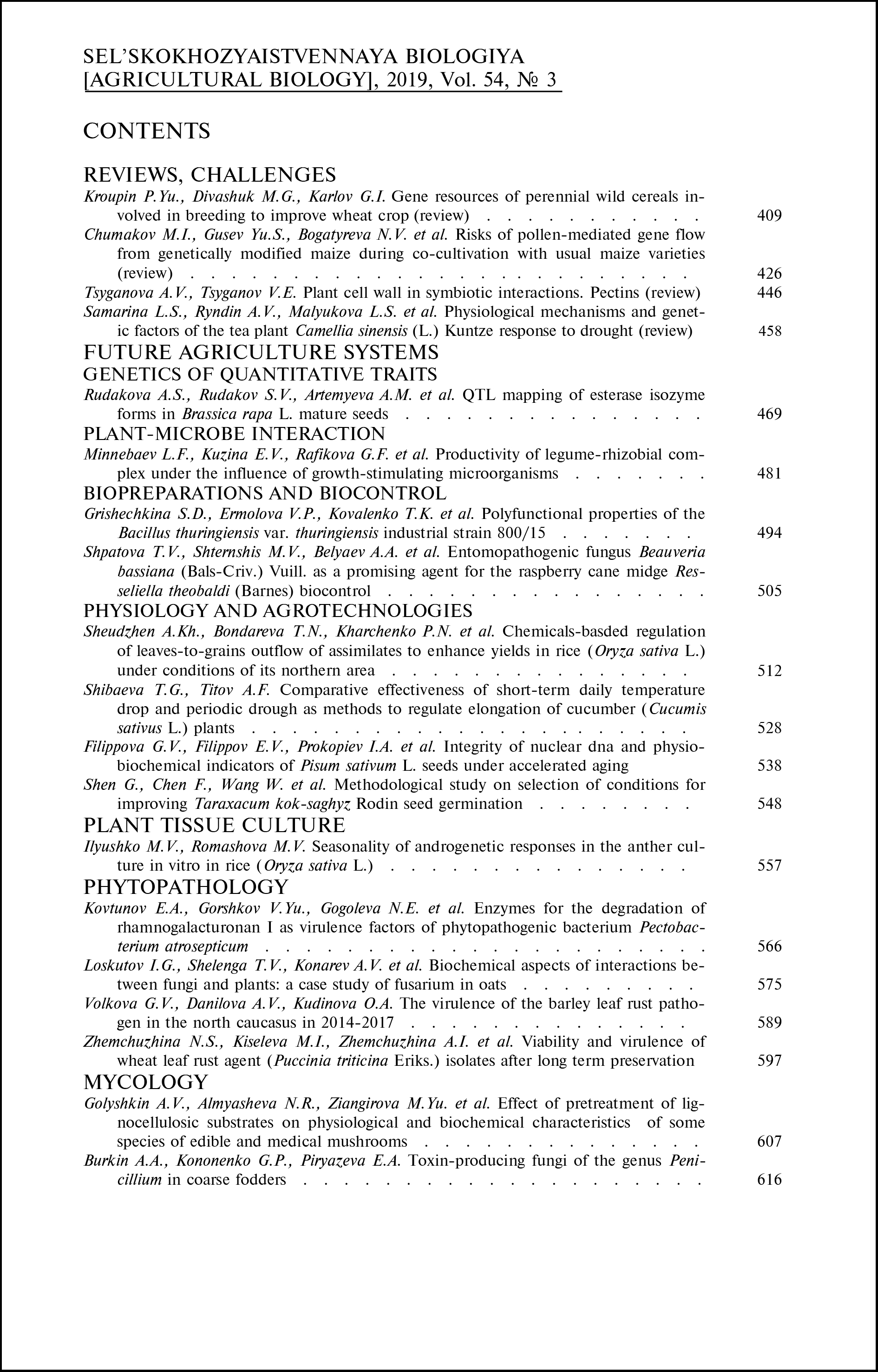doi: 10.15389/agrobiology.2019.3.538eng
UDC: 635.656:581.148.5:575.1::576.3
Acknowledgements:
The study has been carried out within a framework of State task IBPC SB RAS for 2017-2020, No. АААА-А17-117020110056-0.
INTEGRITY OF NUCLEAR DNA AND PHYSIO-BIOCHEMICAL INDICATORS OF Pisum sativum L. SEEDS UNDER ACCELERATED AGING
G.V. Filippova1, E.V. Filippov1, I.A. Prokopiev1, A.A. Shein1,
A.N. Neustroyev2
1Institute for Biological Problems of Cryolithozone, Siberian Branch RAS, 41, prosp. Lenina, Yakutsk, 677980 Russia, e-mail nureeva@yandex.ru (✉ corresponding author), edy73@mail.ru, ilya.a.prokopiev@gmail.com, bg98saa@gmail.com;
2Safronov Yakutsk Research Institute of Agriculture, Siberian Branch RAS, 23/1, ul. Bestuzheva-Marlinskogo, Yakutsk, 677001 Russia, e-mail anneystroevyniisx@mail.ru
ORCID:
Filippova G.V. orcid.org/0000-0002-2024-6062
Shein A.A. orcid.org/0000-0002-3922-5608
Filippov E.V. orcid.org/0000-0003-0269-8943
Neustroyev A.N. orcid.org/0000-0002-8527-0178
Prokopiev I.A. orcid.org/0000-0001-8755-7140
Received September 22, 2018
Currently, much attention is paid to understanding the roles of DNA and the main mechanisms for ensuring stability of the genome in maintaining seed viability during aging. It is also shown that significant oxidative damage to DNA occurs during seed swelling, and active DNA restoration processes are a factor that facilitates the initiation of DNA replication and rapid germination of seeds. Our objective was to study, on the example of two pea varieties and their hybrid, the effect of accelerated seed aging on the level of DNA damage (by DNA comet method) and biochemical indicators (lipid peroxidation, peroxidase activity, content of low-molecular antioxidants) in cells of embryos during seed swelling to find a relationship between these parameters and the changes in physiological parameters of seed germination. It is shown that accelerated aging leads to changes in pea seed germination capacity which are varietal specific, as well as in the biochemical indicators studied. The least resistant to the accelerated aging was Melkosemyannyi 2 variety, and the seeds of Saryal variety were medium-resistant. The seeds of a hybrid of these varieties were the most resistant which may be due to the effect of heterosis. Seed aging causes a significant increase in DNA damage assessed as DNA per cent in the tail of the comet and/or atypical comets. The longer the seeds were under aging conditions, the higher was DNA fragmentation in cells of the embryos upon swelling. Under 24 weeks of accelerated aging, there was a 1.6-3.3 % increase in DNA found in the tail of the comet, and the number of atypical comets in the embryo cells increased 17-40-fold depending on the variety (hybrid) as compared to control. Probably, a significant reduction of seed physiological parameters was caused by higher degree of nuclear DNA fragmentation, decreased enzymatic antioxidants activity (in particular, activity of peroxidases) and intensified oxidation in embryos. Intensification of oxidative processes is expressed as a 2.5-fold excess of lipid peroxidation in germs of a rapidly aging variety which is accompanied by low seed germination. It is assumed that the increase in the degree of DNA damage is a consequence of the depletion of antioxidant and repair enzymes and indicates a slowdown or lack of regenerative processes in the embryos of aging seeds.
Keywords: Pisum sativum, pea, seeds, accelerated aging, germination energy, lipid peroxidation, peroxidase, low-molecular antioxidants, DNA comet.
REFERENCES
- Rajjou L., Duval M., Gallardo K., Catusse J., Bally J., Job C. and Job D. Seed germination and vigor. Annual Review of Plant Biology, 2012, 63: 507-533 CrossRef
- Bewley J.D. Seed germination and dormancy. Plant Cell, 1997, 9: 1055-1066 CrossRef
- Walters C., Wheeler L.M, Grotenhuis J.M. Longevity of seeds stored in a genebank: species characteristics. Seed Science Research, 2005, 15: 1-20 CrossRef
- Miura K., Lin Y., Yano M., Nagamine T. Mapping quantitative trait loci controlling seed longevity in rice (Oryza sativa L.). Theor. Appl. Genet., 2002, 104: 981-986 CrossRef
- Roberts E.H. Storage environment and the control of viability. In: Viability of seeds. E.H. Roberts (ed.). Chapman and Hall, London, UK, 1972: 14-58 CrossRef
- Priestley D.A. Seed aging. Implications for seed storage and persistence in the soil. Ithaca, Cornell University Press, 1986.
- Bailly C. Active oxygen species and antioxidants in seed biology. Seed Science Research, 2004, 14: 93-107 CrossRef
- El-Maarouf-Bouteau H., Mazuy C., Corbineau F., Bailly C. DNA alteration and programmed cell death during ageing of sunflower seed. Journal of Experimental Botany, 2011, 62(14): 5003-5011 CrossRef
- Murthy U.N., Kumar P.P., Sun W.Q. Mechanisms of seed ageing under different storage conditions for Vigna radiata (L.) Wilczek: lipid peroxidation, sugar hydrolysis, Maillard reactions and their relationship to glass state transition. Journal of Experimental Botany, 2003, 54(384): 1057-1067 CrossRef
- Waterworth W.M., Bray C.M., West C.E. The importance of safeguarding genome integrity in germination and seed longevity. Journal of Experimental Botany, 2015, 66(12): 3549-3558 CrossRef
- Burgess R.W., Powell A.A. Evidence for repair processes in the invigoration of seed by hydration. Annals of Botany, 1984, 53(5): 753-757 CrossRef
- Elder R., Osborne D. Function of DNA synthesis and DNA repair in the survival of embryos during early germination and in dormancy. Seed Science Research, 1993, 3: 43-53 CrossRef
- Safina G.F., Filipenko G.I. Trudy po prikladnoi botanike, 2013, 174: 123-130 (in Russ.).
- Alekseichuk G.N., Laman N.A. Fiziologicheskoe kachestvo semyan i metody ego otsenki. Pod redaktsiei S.I. Griba [Physiological quality of seeds and methods for its assessment. S.I. Grib (ed.)]. Minsk, 2005.
- Ermakov A.I. Metody biokhimicheskogo issledovaniya rastenii [Methods of plants biochemistry]. Leningrad, 1987 (in Russ.).
- Lebedeva O.V., Ugarova N.N., Berezin I.V. Biokhimiya, 1977, 42: 1372-1379 (in Russ.).
- Vladimirov Yu.A., Archakov A.I. Perekisnoe okislenie lipidov v biologicheskikh membranakh [Lipid peroxidation in biological membranes]. Moscow, 1972 ).
- Gichner T., Patkova Z., Szakova J., Demnerova K. Cadmium induces DNA damage in tobacco roots, but no DNA damage, somatic mutations or homologous recombination in tobacco leaves. Mutation Research, 2004, 559: 49-57 CrossRef
- Tice R.R., Agurell E., Anderson D., Burlinson B., Hartmann A., Kobayashi H., Miyamae Y., Rojas E., Ryu J.-C., Sasaki Y.F. Single cell gel/Comet assay: guidelines for in vitro and in vivo genetic toxicology testing. Environmental and Molecular Mutagenesis, 2000, 35: 206-221 CrossRef
- Zhanataev A.K., Nikitina V.A., Voronina E.S., Durnev A.D. Prikladnaya toksikologiya, 2011, 2(4): 28-37 (in Russ.).
- Sisman S., Delibas L. Storing sunflower seed and quality losses during storage. Journal of Central European Agriculture, 2004, 4: 239-250 CrossRef
- Mohammadi H., Soltani A., Sadeghipour H.R., Zeinali E. Effects of seed aging on subsequent seed reserve utilization and seedling growth in soybean. International Journal of Plant Production, 2011, 5(1): 65-70 CrossRef
- McDonald M.B. Seed deterioration: physiology, repair and assessment. Seed Science and Technology, 1999, 27: 177-237.
- Avila M.R., Braccini A.L., Souza C.G.M., Mandarino J.M., Bazo G. L., Cabral Y.C.F. Physiological quality, content and activity of antioxidants in soybean seeds artificially aged. Revista Brasileira de Sementes, 2012, 34(3): 397-407 CrossRef
- Morohashi Y. Peroxidase activity develops in the micropylar endosperm of tomato seeds prior to radicle protrusion. Journal of Experimental Botany, 2002, 53: 1643-1650 CrossRef
- Passardi F., Penel C., Dunand Ch. Performing the paradoxical: how plant peroxidases modify the cell wall. Trends in Plant Science, 2004, 9(11): 534-540 CrossRef
- Olive P.L., Banath J.P. Sizing highly fragmented DNA in individual apoptotic cells using the comet assay and a DNA crosslinking agent. Experimental Cell Research, 1995, 221(1): 19-26 CrossRef
- Yasuhara S., Zhu Y., Matsui T., Tipirneni N., Yasuhara Y., Kaneki M., Rosenzweig A., Martyn J.A. Comparison of comet assay, electron microscopy, and flow cytometry for detection of apoptosis. Journal Histochem. Cytochem., 2003, 51(7): 873-885 CrossRef
- Zhanataev A.K., Anisina E.A., Chaika Z.V., Miroshkina I.A., Durnev A.D. Tsitologiya, 2017, 59(3): 163-168 (in Russ.).
- Rundell M., Wagner E., Plewa M. The comet assay: genotoxic damage or nuclear fragmentation? Environmental and Molecular Mutagenesis, 2003, 42: 61-67 CrossRef
- Lorenzo Y., Costa S., Collins A., Azqueta A. The comet assay, DNA damage, DNA repair and cytotoxicity: hedgehogs are not always dead. Mutagenesis, 2013, 28: 427-432 CrossRef












